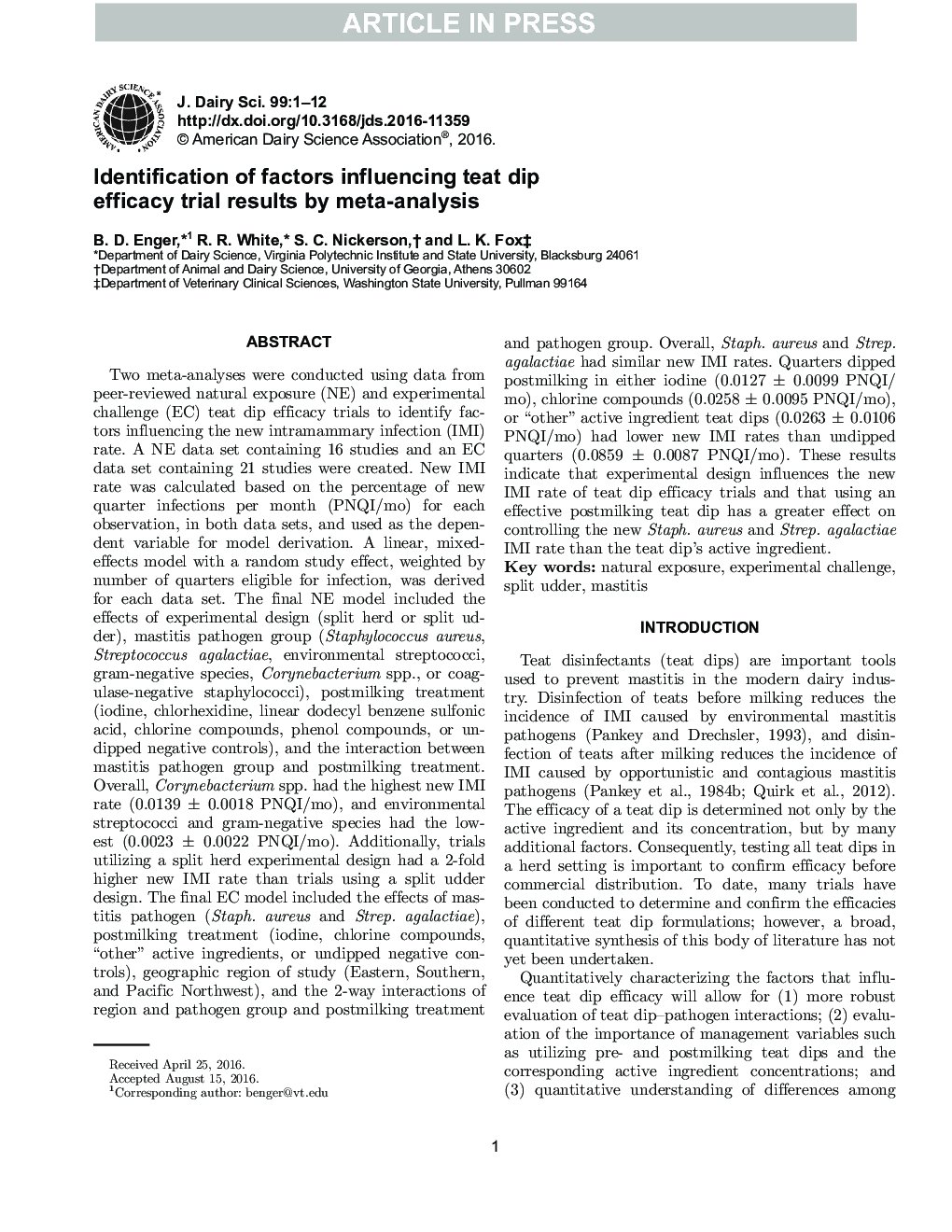| کد مقاله | کد نشریه | سال انتشار | مقاله انگلیسی | نسخه تمام متن |
|---|---|---|---|---|
| 5542760 | 1402522 | 2016 | 12 صفحه PDF | دانلود رایگان |
عنوان انگلیسی مقاله ISI
Identification of factors influencing teat dip efficacy trial results by meta-analysis
ترجمه فارسی عنوان
شناسایی عوامل مؤثر بر نتایج تحقیقات اثربخشی خمیر دندان توسط متاآنالیز
دانلود مقاله + سفارش ترجمه
دانلود مقاله ISI انگلیسی
رایگان برای ایرانیان
کلمات کلیدی
قرار گرفتن در معرض طبیعی، چالش تجربی، پاشیدن پستان، ماستیت،
موضوعات مرتبط
علوم زیستی و بیوفناوری
علوم کشاورزی و بیولوژیک
علوم دامی و جانورشناسی
چکیده انگلیسی
Two meta-analyses were conducted using data from peer-reviewed natural exposure (NE) and experimental challenge (EC) teat dip efficacy trials to identify factors influencing the new intramammary infection (IMI) rate. A NE data set containing 16 studies and an EC data set containing 21 studies were created. New IMI rate was calculated based on the percentage of new quarter infections per month (PNQI/mo) for each observation, in both data sets, and used as the dependent variable for model derivation. A linear, mixed-effects model with a random study effect, weighted by number of quarters eligible for infection, was derived for each data set. The final NE model included the effects of experimental design (split herd or split udder), mastitis pathogen group (Staphylococcus aureus, Streptococcus agalactiae, environmental streptococci, gram-negative species, Corynebacterium spp., or coagulase-negative staphylococci), postmilking treatment (iodine, chlorhexidine, linear dodecyl benzene sulfonic acid, chlorine compounds, phenol compounds, or undipped negative controls), and the interaction between mastitis pathogen group and postmilking treatment. Overall, Corynebacterium spp. had the highest new IMI rate (0.0139 ± 0.0018 PNQI/mo), and environmental streptococci and gram-negative species had the lowest (0.0023 ± 0.0022 PNQI/mo). Additionally, trials utilizing a split herd experimental design had a 2-fold higher new IMI rate than trials using a split udder design. The final EC model included the effects of mastitis pathogen (Staph. aureus and Strep. agalactiae), postmilking treatment (iodine, chlorine compounds, “other” active ingredients, or undipped negative controls), geographic region of study (Eastern, Southern, and Pacific Northwest), and the 2-way interactions of region and pathogen group and postmilking treatment and pathogen group. Overall, Staph. aureus and Strep. agalactiae had similar new IMI rates. Quarters dipped postmilking in either iodine (0.0127 ± 0.0099 PNQI/mo), chlorine compounds (0.0258 ± 0.0095 PNQI/mo), or “other” active ingredient teat dips (0.0263 ± 0.0106 PNQI/mo) had lower new IMI rates than undipped quarters (0.0859 ± 0.0087 PNQI/mo). These results indicate that experimental design influences the new IMI rate of teat dip efficacy trials and that using an effective postmilking teat dip has a greater effect on controlling the new Staph. aureus and Strep. agalactiae IMI rate than the teat dip's active ingredient.
ناشر
Database: Elsevier - ScienceDirect (ساینس دایرکت)
Journal: Journal of Dairy Science - Volume 99, Issue 12, December 2016, Pages 9900-9911
Journal: Journal of Dairy Science - Volume 99, Issue 12, December 2016, Pages 9900-9911
نویسندگان
B.D. Enger, R.R. White, S.C. Nickerson, L.K. Fox,
